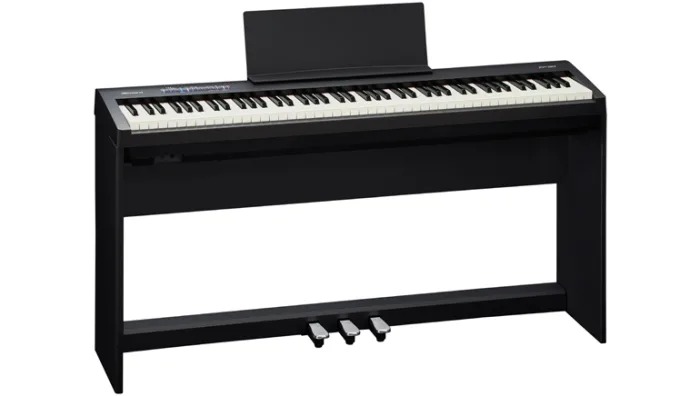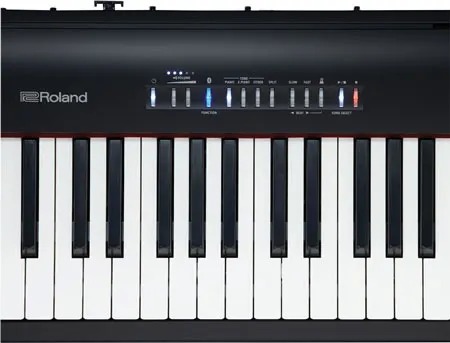Roland FP-30 review

Roland pretty much invented the under-a-grand, under-30-Pounds digital piano a quarter-century ago when the manufacturer introduced the EP-7. Semi-weighted and only 76 keys, it was a godsend to the legions of players who simply wanted something small and lightweight for gigs and living rooms. The touch was addictive, and the piano and electric piano sounds, though unsophisticated by today’s standards, were highly musical. Roland, as usual, was ahead of the marketplace.
That’s why I was so curious to play the new FP-30: It is the latest incarnation of the portable digital-piano concept and Roland’s entry in the current under-a-grand, fully weighted, 88-key piano race.
A clean machine
The Roland FP-30 is the size of its competitors but weighs in at about five pounds more than the others, lending it a reassuring substantiality. And it has a super-clean design.
Available in black or white, the FP-30 offers many of the features that have become de rigueur in this category, layering (called Dual here), split and twin-piano modes, 128-note polyphony, a metronome, a pre-programmed rhythm machine, WAV file playback, USB connectivity, and a (single-track) MIDI recorder with SMF playback capabilities so you can play along with multitrack song files. A pair of built-in 4.75" speakers, each with an 11W amplifier, provides onboard sound. Moreover, the FP-30 sends MIDI over Bluetooth so you no longer need a USB cable or Camera Connection kit to control your favourite music apps.
As far as stands for the FP-30 are concerned, Roland suggests the KSC-70 ($99) or one of their latest x-or z-frame stands. And if you opt for the 3-pedal KPD-70 ($75 street), you can use it to turn pages in compatible sheet-music apps such as Sheet Music Direct and piaScore using a pedal command.
The FP-30’s rear panel hosts two USB ports (one for a thumb drive, another for computer connection) and two pedal inputs (1/4" and a multipin jack). For analogue audio output, you have your choice of 3.5mm and 1/4" headphone jacks on the front, below the keyboard. Because there are no discrete 1/4" audio jacks, you will need an insert cable to feed the output to a pair of studio monitors or mixer inputs; for example, a cable with a 1/4" TRS plug on one end (for the piano’s headphone output) that splits to a pair of 1/4" TS jacks. (A forthcoming update will allow you to use the headphone outs without muting the speakers.)
The piano experience
When it comes the FP-30’s raison d’être, it’s the piano sound provided by Roland’s SuperNatural engine. It is not a uniformly voiced, perfectly even instrument that you find on the competitor’s keyboards; here there are subtle note-to-note variations. And the onboard amplification, heartier than most with speakers that shoot downward, emphasises lows and mids more than my studio-spoiled ears have come to prefer. And as I played, I realized that something special was happening. With all its realistic variation in tone, Roland has caught the essence of a fine piano. It feels like one of those big grands that you hear on Keith Jarrett records. In fact, through the built-in speakers, the lows and mids are so rich and, at the same time, precise, that you can voice 1-3-5 triads down around low C and hear every tone distinctly.
Want all the hottest music and gear news, reviews, deals, features and more, direct to your inbox? Sign up here.
The high octaves are convincing as well, with a few notes being a little quirky – G# over middle C comes to mind. But I got tremendous enjoyment out of those bottom three octaves. The action is so responsive (“bouncy” in that Roland way) that you can do very funky things. And the richness coming out of the internal speakers supports singers effortlessly, male and female. All in all, the marriage of the ultra-nimble, exquisitely textured keys and this exceptional piano engine make for satisfying and emotional playing experience.
EPs, organs, and other goodies
If you like Roland electric pianos, you’ll enjoy the three choices here, a chimey-Dyno Rhodes, a tiny ’80s digital, and a funky Wurly simulation. The FP-30 also includes a very nice pair of jazz organs that will cover most gigs. And it has the bass basics covered, acoustic and finger-style electric, and the usual assortment of guitars, harpsichords, celestes, vibes, and such. I would rather have had a couple more electric pianos than the seven vocal-based patches, but I wouldn’t want to lose the velocity-driven Jazz Scat patch.
Digging for sounds
Because there are only 13 buttons on the top of the FP-30, accessing many of its functions and sounds requires you to use button and keyboard-note combinations (see Figure 1). Moreover, there are no dials or sliders for control and no display to see what you’ve selected.

A clean machine
The FP-30 provides 35 Tone presets. To select a preset within the Piano, E Piano or Other category, press a Tone button along with the appropriate piano key in the lower octave; the full instrument list and note position can be referenced in the manual. To layer a pair of sounds, press two Tone buttons simultaneously. The FP-30 also holds 30 songs and a collection of eight drum patterns, the latter being 1-and 2-bar loops in a variety of styles.
To access the majority of parameter settings, hold down the Function button and press a piano key. The features available include ambience, EQ, transposition, selecting an internal song, dialling in an exact metronome tempo, and tuning. Although there are some lightly printed reminders on the instrument itself, they don’t cover all the functions. So until you memorize the control sequences you are likely to use most often, you’ll need the manual by your side.
The challenges of remembering how to navigate the interface kept me from bringing the FP-30 to a complex real-world gig where I had to quickly change sounds, set split-levels and do instant, reliable transpositions. On the other hand, I had no trouble using it for a party where I only needed an acoustic piano, a couple of EPs and acoustic bass. And throughout, the Tones sounded gorgeous, whether they were heard through my P.A. speakers or my keyboard amp.
Overall, the FP-30 is an expressive and fine-sounding musical instrument, and it is a must-play if you’re shopping for a digital keyboard for home or stage.
Verdict
Pros
Emotional, convincing and very playable grand piano sounds with an ergonomically thrilling action that brings out the best in it. Giggable sound array. Bluetooth MIDI connection to music apps.
Cons
No visual display. No quarter-inch outputs. No data entry slider or dial. Only three tone category buttons. Many functions and Tone selection requires you press a combination of a button and keyboard note.
Bottom Line
A great-playing, authentic-sounding digital piano.
$699 street
rolandus.com